I always wait until the last moment to complete my year-end lists because in this job the unexpected is to be expected. Who knows what the final days of a year will bring? As it’s now almost 11:00 p.m. on New Year’s Eve, though, I think it’s probably safe to close the books on 2012. So, back to the countdown …
5. Pacific Islands Forum
A clear choice for the Top Ten list again this year was the Pacific Islands Forum (PIF), held on Rarotonga in the Cook Islands. Trumping our participation last year, Secretary of State Hillary Clinton led the largest and highest-level U.S. delegation ever to attend the annual event in its 41-year history. For the second year in a row my Embassy hosted the delegation because the Cook Islands is within our area of accreditation.
With the Secretary and me were the Governor of American Samoa Togiola Tulafono, several of my fellow Ambassadors, U.S. Pacific Commander Admiral Samuel Locklear, Coast Guard Commander Rear Admiral Charles Ray, and other senior officials from the White House, USAID, Peace Corps, Department of State, Department of the Interior, Department of Defense, Department of Homeland Security, and several other agencies.
The delegation came to work. As we did last year, my team and I scheduled our various principals for more than 120 separate meetings and public appearances with officials from other nations, NGOs, multilateral institutions, businesses, and citizens groups. It was a punishing but highly productive schedule for the 48 hours or so that most of our visitors were in town, as well as for the week that my team spending preparing for the deluge of arrivals.
![Secretary Clinton and Delegates to the Pacific Islands Forum pose for a family photo at the Cook Islands National Auditorium, August 31, 2012. [State Department photo by Ola Thorsen/ Public Domain] Secretary Clinton and Delegates to the Pacific Islands Forum pose for a family photo at the Cook Islands National Auditorium, August 31, 2012. [State Department photo by Ola Thorsen/ Public Domain]](https://webarchive.library.unt.edu/web/20130218071904im_/http://farm9.staticflickr.com/8449/7947613372_c852624ebf.jpg)
Secretary Clinton poses for a family photo with Forum leaders and Post-Forum Dialogue heads of delegation. She is flanked by Prime Ministers Key (left) and Puna (right) of New Zealand and the Cook Islands, respectively.
In all, over the course of the PIF, Secretary Clinton launched a large number of new initiatives of mutual benefit to the island nations and the United States on issues of regional security, sustainable development, marine protection, climate change, gender equality, education, and economic partnership. Oriented toward capacity building, people-to-people engagement, and entrepreneurial self-reliance, the initiatives provide a recipe for empowerment, not dependency. For a full list of the extensive business accomplished, see my September post about the PIF.
4. Auckland Consulate General Restructuring
As I’ve discussed before, we’ve been engaged in a good bit of internal restructuring at the Mission to bring our programs, staffing, resources, and methods into alignment with current, rather than legacy, circumstances and priorities. That’s all much more difficult than you might imagine, but it’s essential to becoming more effective at our work. Simply put, there wouldn’t be a credible Top Ten list without our restructuring activity. In 2011 we focused on retooling the Embassies in Wellington and Apia (which is why “Embassy Restructuring” was #4 of my 2011 Top Ten). In 2012 we focused intensely on the Consulate General in Auckland.
When I presented my credentials in December 2009, we had a full consular team but just one catch-all program staff position in Auckland despite that city representing more than a third of New Zealand’s population. (The population percentage increases even further if one includes the greater metro area, which I define as the places within an easy day’s commute of the Auckland CBD.) Such a skeletal deployment makes very little sense and certainly impaired our effectiveness.
Over the past year we’ve corrected the problem by creating new portfolios and moving several existing American-officer and locally-engaged positions from Wellington to Auckland. In doing so we have rebalanced our program staff to achieve a roughly 50/50 split between our two facilities, and have created in Auckland fully functioning economic, political, public diplomacy, and public affairs teams. I am particularly excited about positions we’ve created in Auckland for university outreach, educational advising, and Pacific communities engagement. The changes are already producing results, and will pay dividends far into the future.
3. Secretary Leon Panetta’s Visit to New Zealand
We hosted our third visit of the year by a senior member of the Cabinet when Secretary of Defense Leon Panetta came to Auckland in September. The first American Secretary of Defense to visit New Zealand in more than 30 years, Secretary Panetta engaged in a busy two days of meetings, including with Prime Minister John Key, Minister of Defence Dr. Jonathan Coleman, and Leader of the Opposition David Shearer.

Secretary of Defense Leon Panetta being welcomed at Government House in Auckland.
The visit takes a place high on the 2012 Top Ten list because it was emblematic of the tangible revitalization of security relations between the two countries over the past two years.
In June, Secretary Panetta and Minister Coleman signed in DC the Washington Declaration, a short statement that expressed our joint commitment to expand defense cooperation and establish regular senior-level strategic security policy dialogues.
Earlier in the year New Zealand hosted both the first U.S.-N.Z. joint air exercises and the first U.S.-N.Z. joint army/marine exercises in more than a quarter century.
Also this year New Zealand was invited for the first time ever to send a ship to participate in the U.S.-sponsored RIMPAC, the world’s largest international maritime exercise.
Such engagement is of significant benefit to both our societies, as well as to our neighbors. In an unpredictable world, enhanced coordination and interoperability will allow us to respond together more quickly and effectively to natural disasters, humanitarian crises, and other exigencies here in the Pacific. Compelling evidence of what I mean was our joint U.S. Coast Guard / Royal New Zealand Air Force mission a year ago to provide emergency fresh water supplies to Tokelau, thus averting a crisis.
The steps taken this year were wise, long-overdue, and mutually beneficial. Considered together, the Washington Declaration and the Wellington Declaration provide a framework for engagement that both looks confidently forward and reaffirms the deep, vibrant partnership that our two countries have historically maintained.
2. Celebration of Samoa’s 50th Independence Day
On June 1, 2012, the nation formerly known as Western Samoa celebrated its 50th Independence Day. As you may recall from several of my posts that month, our Embassy Apia team put together an impressive schedule of substantive and ceremonial events to mark the august occasion and underscore the long, deep history of U.S.-Samoa friendship. In fact, the United States had the largest, most diverse, and most vibrant international presence at the independence celebrations.
I led an official Presidential Delegation appointed by the White House which included, among others, Admiral Cecil Haney (Commander of the U.S. Pacific Fleet), Congressional Delegate Eni Faleomavaega, and my colleague Ambassador Frankie Reed (our current American Ambassador to Suva, and former Chargé d’Affaires at Embassy Apia). We brought with us the U.S. Navy destroyer USS Chafee (with 350 sailors on board), the N.O.A.A. climate research vessel Ka’imimoana, and several Coast Guard and Navy aircraft for ceremonial fly-overs.
Our U.S. Navy 7th Fleet Band paraded and played concerts on Upolu and Savaii. The acclaimed African American step group Step Afrika! performed at schools, in church halls, and on stage at the national variety show. The Navy musicians, steppers, Peace Corps volunteers, my Embassy colleagues, and I all marched together in the official procession on Independence Day. And we hosted several dinners and receptions at our new Chargé Residence, including for the Samoa Chamber of Commerce, the large number of fellow Americans from American Samoa who attended the festivities, and senior government officials.
In terms of substantive activity, we announced our plans to build a new district medical center near the airport. We awarded several economic development grants. And Prime Minister Tuilaepa and I signed a Shiprider Agreement which will allow the Government of Samoa to place Samoan law enforcement officers on American Coast Guard and Navy ships passing through Samoan waters. Those officers will be able to direct the interdiction, arrest, and fining of foreign vessels engaged in illegal commercial fishing, trafficking in persons, or trafficking in prohibited substances, all serious problems in parts of the Pacific.
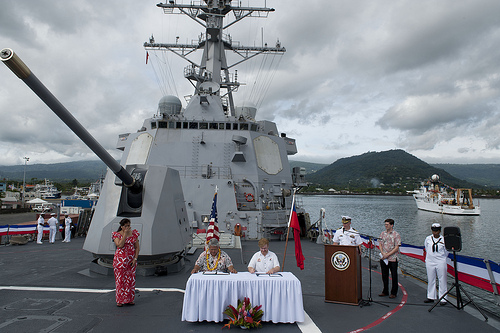
Prime Minister Tuilaepa and I sign the Shiprider Agreement on the USS Chafee (with the Ka’imimoana in the background at right). Illegal fishing vessels, beware.
One of the highlights of our program was a reception aboard the USS Chafee after we signed the Shiprider Agreement on the foredeck. The 7th Fleet Band entertained guests including the Prime Minister, Head of State, King of Tonga, Governor-General of New Zealand, Governor of American Samoa, Deputy Prime Minister, several Cabinet Ministers, senior officials from French Polynesia, and heads of NGOs active in Samoa.
Our commemoration of Samoa’s 50th year of independence was, in my view, the most impressive and successful effort in the history of Embassy Apia. My colleagues underscored meaningful historical linkages and ongoing collaborations, while taking significant steps to deepen and expand relations further. Our Apia team planned for many months and then, along with visiting support from Wellington and Auckland, worked 15-hour days for more than a week to implement the program. It was the kind of effort that puts a big smile on your face, and easily ranks as one of our top two Mission efforts of 2012.
1. Celebration of the 70th Anniversary of US-NZ Bilateral Relations
and the Arrival of American Forces during World War II
In a photo-finish with the Samoa 50th, the top slot on my 2012 list goes to the Mission’s extensive commemorations of two highly significant milestones in shared Kiwi/American history. In February we marked the 70th anniversary of the establishment of formal diplomatic relations between the two countries, and in June we marked the 70th anniversary of the arrival of American military forces in New Zealand at the request of Prime Minister Peter Fraser after the outbreak of World War II in the Pacific.
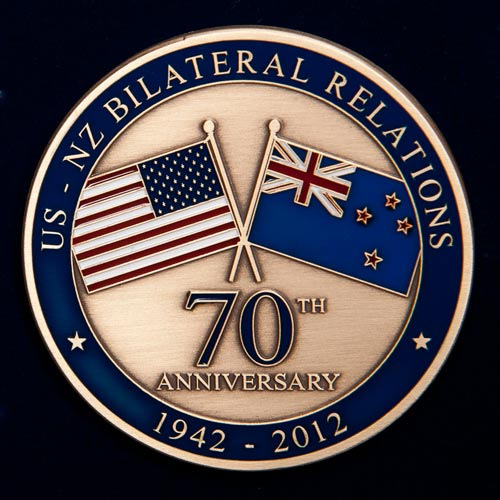
 It’s difficult to talk briefly about the anniversaries because the program spanned virtually the entire year, starting with social media efforts in February and concluding with the Marine Ball in November. I’ve already written more than a dozen blog posts about various elements of the commemorations, so I won’t recount the details again here.
It’s difficult to talk briefly about the anniversaries because the program spanned virtually the entire year, starting with social media efforts in February and concluding with the Marine Ball in November. I’ve already written more than a dozen blog posts about various elements of the commemorations, so I won’t recount the details again here.
I’ll simply say that, inter alia, we produced stamps, minted coins (at left), sponsored a 1940s video contest for students, held a memorial concert at Old St. Pauls, took the U.S. Marine Forces Pacific Band on a 3-week concert tour of cities and towns that had hosted Americans during the war, and held large 1942-themed Independence Day receptions for almost 1,500 folks in Wellington, Auckland, and Christchurch.
We talked live and online about the importance of shared history … Walter Nash’s arrival in DC to establish New Zealand’s first ever diplomatic mission abroad … the bedrock relationship formed when more than 150,000 American servicemen and women came to New Zealand during the war … and the shared service and sacrifice of our respective forebears during some of the darkest days of the prior century.
The Government of New Zealand held a wreath-laying ceremony at the National War Memorial attended by the Prime Minister, Governor-General, Leader of the Opposition, Minister of Defence, and other dignitaries. There was a moving sunset retreat on the Parliament forecourt with the Prime Minister and Governor-General, followed by a Parliamentary reception. Commemorative statements were read in the House, and New Zealand Post issued a set of anniversary stamps. The Kapiti Council and Kapiti U.S. Marines Trust held a series of additional events.
There was great warmth in the celebration of our shared history, which is the rock-solid foundation on which the relationship between the two nations still stands, whatever the vagaries of the politics of the day. Seventy years on, Kiwis and Americans still stand shoulder to shoulder on the issues that matter the most in the world. We advocate together for universal human rights from a position of deeply held, shared civic values. We still serve and sacrifice together in peacekeeping and reconstruction efforts around the world.
And we work closely together on a wide variety of economic development, climate change, disaster response, gender equality, rule of law, political empowerment, and other projects. In a show-me-the-money era when values are often viewed as quaint inconveniences, it’s important to remind ourselves that first principles rather than pecuniary gain bind our relationship together.

The swing unit of the U.S. Marine Corps Forces Pacific Band performs in Wellington Town Hall under an image of 1942 forebears in Wellington’s Majestic Cabaret.
Of course, we don’t always agree on everything. But really, that’s to be expected. If we don’t occasionally squabble, then we aren’t being honest with each other. What matters is not the 5% or so of the time that we disagree, but the 95% of the time that our instincts, interests, and priorities naturally align. And what matters most of all is how we deal with disagreement when it occurs.
By those measures and all accounts, 2012 was a very good year.
* * *
That’s it for now. I hope you’ve enjoyed this brief tour through the highlights of another gratifying year at American Missions New Zealand and Samoa. Our 2010 was an excellent year significantly surpassed by 2011, which in turn has been exceeded by 2012. I’m very much looking forward to the pleasures and challenges of maintaining that steep trajectory in 2013.
Next year brings another couple of special anniversaries. October 12, 2013 marks the 175th anniversary of American diplomatic presence in Aotearoa. On that date in 1838, U.S. Secretary of State John Forsyth commissioned John R. Clendon to be the first United States consul in the lands later to be called New Zealand.
In addition, August will mark the 70th anniversary of First Lady Eleanor Roosevelt’s iconic island-hop trip through the South Pacific during the height of the war. From August 27 through September 2, 1943, Mrs. Roosevelt stopped in New Zealand to tour Red Cross facilities, visit marae, raise the profile of women’s contributions to the war effort, and engage with soldiers and civilians in Auckland, Rotorua, and Wellington.
Plans are afoot …
For now, though, Dr McWaine and I, and everyone else at American Missions New Zealand and Samoa, wish you and yours a very happy, healthy, and rewarding New Year … Kia hari te Tau Hou … Ia manuia le Tausaga Fou … Hau’oli Makahiki Hou.
![]()
 RSS
RSS
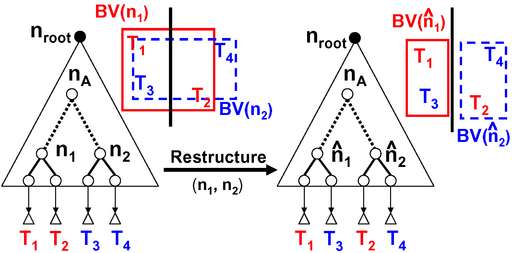



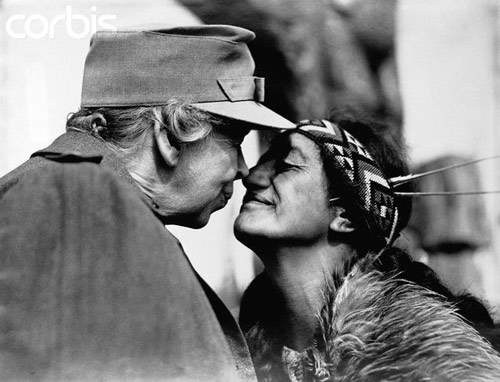
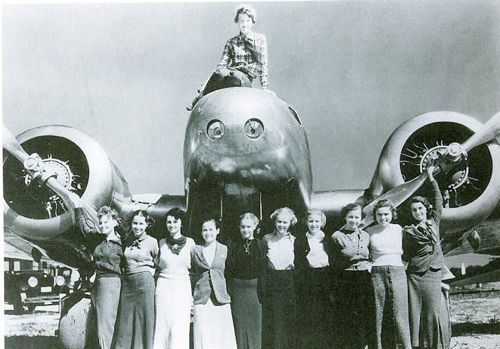






 View my Profile
View my Profile Connect with Wellington
Connect with Wellington Watch our Videos & Subscribe
Watch our Videos & Subscribe Watch our Videos on Vimeo
Watch our Videos on Vimeo Connect on GPlus
Connect on GPlus US Embassy NZ
US Embassy NZ


 Post Entries (RSS)
Post Entries (RSS)

